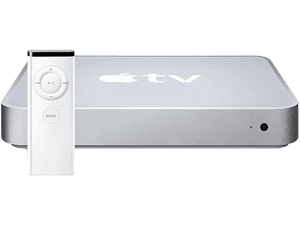 Once known as iTV, Apple TV was officially unveiled at Macworld 2007 and arrives in February. With its built-in hard drive and 802.11n wireless streaming, this little white box finally brings together iTunes and the TV.
Once known as iTV, Apple TV was officially unveiled at Macworld 2007 and arrives in February. With its built-in hard drive and 802.11n wireless streaming, this little white box finally brings together iTunes and the TV.Apple TV is a network media box that streams movies, music, TV shows, podcasts, and photos from the iTunes library on your PC or Mac to your HDTV. The box, which looks like a squashed Mac Mini and measures 7.7 by 7.7 by 1.1 inches (including an integrated power supply), connects to your TV via either HDMI or component video and audio, and wirelessly syncs content from your iTunes library so that you can enjoy it in the living room using the included remote. As promised, Apple TV will be available in February for $299; you can order it online now.
Another big question mark was the file formats that Apple TV would support, and here we have some clear answers. It goes without saying that Apple TV will work with any standard iTunes format. Audio formats include AAC, protected AAC (from iTunes Store), MP3 and variable bit rate MP3, Apple Lossless, AIFF, and WAV. But the bigger news is it supports wide-screen, high-definition video, more specifically 1,280x720 at 24 frames per second, aka 720p. That means you will be able to view movies and TV shows at better-than-DVD quality--as long as you can get them from the iTunes Store. Other video formats include H.264 and protected H.264 (from iTunes Store), 640x480 at 30 frames per second; 320x240 at 30 frames per second; and MPEG-4, 640x480 at 30 frames per second. Finally, Apple TV supports all standard photo formats, including JPEG, BMP, GIF, TIFF, and PNG; you can view photos in slide shows on your TV.
 Right now, the movie selections on iTunes Store are limited to Disney and its affiliated studio brands, such as Touchstone and Miramax. But at Macworld, Apple CEO Steve Jobs also announced a deal with Paramount that makes an additional 250 movies available for iTunes, the iPod, and now Apple TV. That's a great step, but with the exception of a few "season passes," Apple still charges a flat fee for movies ($9.99 to $12.99) and TV shows ($1.99 per episode). The introduction of Apple TV makes it more apparent than ever that Apple should rapidly expand the video offering of iTunes Store, make more of it available in wide-screen HD formats, and especially provide the option for a monthly subscription fee like many of its competitors do.
Right now, the movie selections on iTunes Store are limited to Disney and its affiliated studio brands, such as Touchstone and Miramax. But at Macworld, Apple CEO Steve Jobs also announced a deal with Paramount that makes an additional 250 movies available for iTunes, the iPod, and now Apple TV. That's a great step, but with the exception of a few "season passes," Apple still charges a flat fee for movies ($9.99 to $12.99) and TV shows ($1.99 per episode). The introduction of Apple TV makes it more apparent than ever that Apple should rapidly expand the video offering of iTunes Store, make more of it available in wide-screen HD formats, and especially provide the option for a monthly subscription fee like many of its competitors do.


